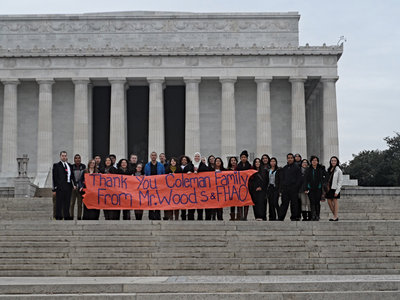“I’d love to change the world, but I don’t know what to do,” said a 1960s-era political rock song, and the conundrum is something that Bayonne High School social studies teacher Gene Woods would like to change. His class, “Facing History and Ourselves,” is part of a study of human history and how to prevent things like the Holocaust.
“We have the power to change things,” Woods said, talking about the history class, which involved a study of horrific human events that culminated in interviewing two Bayonne survivors of the Holocaust. The class took a trip to the United States Holocaust Memorial Museum in Washington, D.C. earlier this year, which was sponsored by the Coleman Family, owners of International-Matex Tank Terminals (IMTT).
The program hoped to give students a firsthand experience and a greater appreciation for learning about the Holocaust and the importance of being an upstanding member of society.
“It’s about personal power,” Woods said. “We are trying to figure out why humans have acted this way through history, and to figure out how to stop things like the Holocaust from happening. It’s about how individuals can improve the world.”
The course, which examines the concept of universal rights, includes looking at institutions such as the United Nations, which was formed after World War II partly as a way to improve communications among countries in an attempt to avoid conflict of that magnitude in the future. Woods said the class will conclude with a look at the Civil Rights Movement to see how people can fight for their rights and fight for everyone’s equality.
“But you have to stand up,” he said.
At the conclusion to the project, students will look at what they can do to change society, not huge changes maybe, but significant improvements that go beyond themselves—changing the local ecology to be a greener and cleaner or something as simple as getting healthier foods in the cafeteria.
“Some are trying to develop peace organizations in Bayonne that will promote peace and understanding on a community level,” Woods said.
In a session that was televised on Bayonne Educational Network, students from Woods’ class interviewed Katie Berces and Regina Resnick, two survivors of the Holocaust. They heard the women’s stories of tragedy and eventual liberation from Nazi death camps during World War II.
“I have worked with these special women for over five years now and each time I learn something new about their experiences during the Holocaust,” Woods said, hoping that their message would allow his students to bear witness to history from those who lived it.
Student interviewers asked questions about everyday life and feelings during one of history’s most shameful moments, and heard accounts of heroism and human dignity that reverberated far beyond the room.
Student reactions to the trip
Justin May, a student who was involved in these events and the trip to Washington, D.C., called it “an exhilarating experience.”
“When we actually arrived at the museum, I was shocked because of all of the visuals that were provided by the museum,” May said. “All of these visuals affected me emotionally and it was actually like reliving history.”
Nicole Garzon said the experiences came into focus when she got to the museum.
“Before, in class, we learned about much of what we saw at the museum but it had not really stuck with me until I saw it firsthand,” she said. “Seeing the progression of the Holocaust, from the rise of the Nazis to the liberation of the camps, was incredibly moving. The thought that anything remotely close to the Holocaust could happen to anyone in our time is disturbing.
Kassandra Ferma was also impressed.
“I felt like I was a different person after leaving the Holocaust Memorial Museum from when I first entered the museum,” Ferma said. “The museum instilled a plethora of new information that I did not learn about the Holocaust from school textbooks. Reading about the Holocaust is a much different experience than actually living it. The class was exposed to numerous possessions from the unknown prisoners. For instance, we saw a large pile of shoes from the prisoners. In fact, the room that the shoes were placed in smelled like old leather which made the experience much more real to me. We had a little taste of the lives of the Holocaust victims and I realized that I should not take my life for granted.”
Ashley Buchanan called it “an amazing experience.”
“When we visited the Holocaust Museum and walked around, I was speechless,” she said. “Textbooks and pictures can only do so much in aiding one’s learning experience. Sometimes we have to be able to form our own connections in order for certain events to resonate deep in our heart.”
“This was more than just a simple field trip,” said Cassandra Wernock. “Visiting the museum was a crucial part in our understanding of the Holocaust and the lives of the victims. Reading and learning about the Holocaust in class is one thing, but it is another to actually see the artifacts like the leather shoes and cattle cars in person.”
Ximena Duran said the trip made the Holocaust real.
“The experience became so real to me as I walked through those floors and learned about new aspects that I could have never really connected to with a textbook. I remember hearing one quote from a survivor that truly stuck with me, and made me think, ‘How do you explain fear?’ How do you explain hunger to someone who probably had breakfast and lunch today?’ Being at this museum and being able to learn from history a step deeper made me realize that opportunities this eye opening don’t just happen to anyone.”
Al Sullivan may be reached at asullivan@hudsonreporter.com
